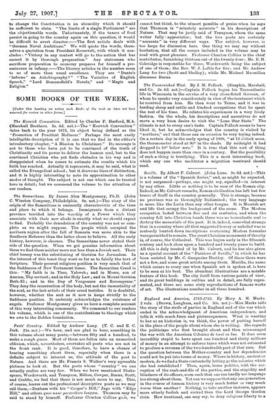Seville. By Albert F. Calvert. (John Lane. 3s. 6d. net.)—This
is a volume of the "Spanish Series," and, as might be expected, is not surpassed—perhaps, one might say, equalled—in interest by any other. Little or nothing is to be seen of the Roman city. Indeed, as Mr. Calvert remarks, Roman civilisation has left but few traces of itself in the country generally. This is strange, because no province was so thoroughly Italianised ; the very language is more like the Latin than any other tongue. It is Moorish art and life that occupy the background of the scene. The Moslem occupation lasted between five and six centuries, and when the country fell into Christian bands there was no iconoclastic zeal to destroy the memorials of the past. It is, indeed, somewhat strange that in a country where all that suggested heresy or unbelief was so zealousiy bunted down inscriptions containing Moslem formulas were permitted to remain. The great Christian monument of the city is, of course, the Cathedral. This was begun early in the fifteenth century and took close upon a hundred and twenty years to build. All this is duly treated of by Mr. Calvert, and he has also given us a special account of the "Painters of Seville," in which he has been assisted by Mr. C. Gasquoine Hartley. Of these there were not a few, and some great artists among them. Murillo, the name which occurs to every one when Spanish art is spoken of, is here to be seen at his best. The abundant illustrations are a notable feature of this book. The city itself from various points of view, and its great buildings in outline and in detail, are fully repre- sented, and there are some sixty reproductions of famous works of art. The illustrations number in all three hundred.






































 Previous page
Previous page